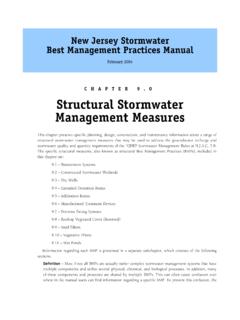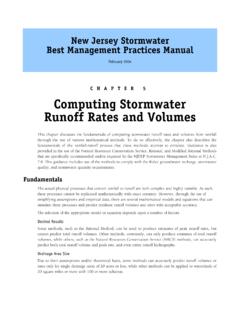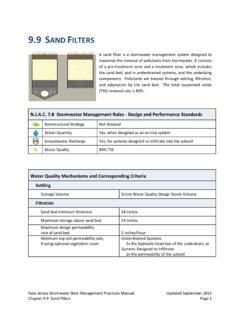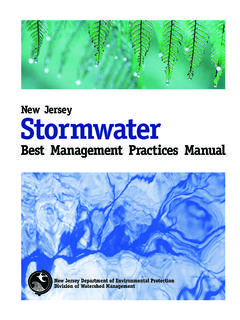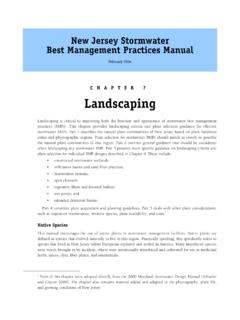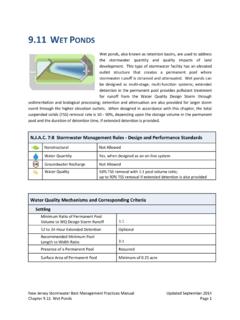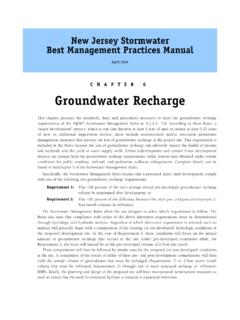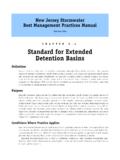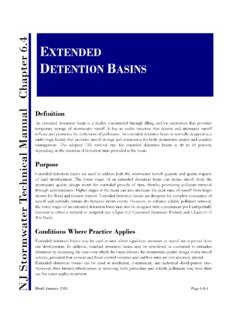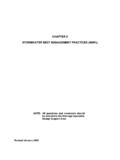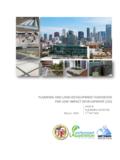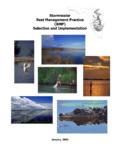Transcription of CHAPTER 2 Low Impact Development Techniques
1 New Jersey StormwaterBest management practices ManualFebruary 2004 CHAPTER 2 Low ImpactDevelopment TechniquesAs described in CHAPTER 1, land Development can have severe adverse stormwater impacts, particularly if theland is converted from woods, meadow, or other natural condition to a highly disturbed area with largepercentages of impervious and non-native vegetated covers. Such impacts typically include an increase instormwater runoff volume, rate, velocity, and pollutants and a corresponding decrease in the quality ofrunoff and stream flow. Frequently, management of these impacts has focused on collecting and conveyingthe runoff from the entire site through a structural conveyance system to a centralized facility ( ,detention basin, wet pond) where it is stored and treated prior to discharge downstream. In effect, suchpractices first allow the adverse runoff impacts to occur throughout the site and then provide remedialand/or restorative measures immediately prior to releasing the runoff the 1960s, the range of remedial measures provided in centralized treatment facilities has increasedfrom merely 100-year peak flow attenuation to the range of peak flow, volume, and nonpoint sourcepollutant controls required by New Jersey s current stormwater management Rules at 7:8.
2 This hasrequired modifications to established methods of runoff computation and the Development of alternativetreatment methods to be used in centralized , with the increasing emphasis on nonpoint source pollution and concerns over theenvironmental impacts of land Development , it has become necessary to develop effective alternatives to thecentralized conveyance and treatment strategy that has been the basis for much of the stormwatermanagement systems and programs in the state. New strategies must be developed to minimize and evenprevent adverse stormwater runoff impacts from occurring and then to provide necessary treatment closerto the origin of those impacts. Such strategies, known collectively as Low Impact Development or LID, seekto reduce and/or prevent adverse runoff impacts through sound site planning and both nonstructural andstructural Techniques that preserve or closely mimic the site s natural or pre-developed hydrologic responseto precipitation.
3 Rather than responding to the rainfall-runoff process like centralized structural facilities,low Impact Development Techniques interact with the process, controlling stormwater runoff and pollutantscloser to the source and providing site design measures that can significantly reduce the overall Impact ofland Development on stormwater runoff. As such, low Impact Development promotes the concept ofdesigning with Jersey stormwater best management practices manual CHAPTER 2: Low Impact Development Techniques February 2004 Page 2-2 Effective low Impact Development includes the use of both nonstructural and structural stormwatermanagement measures that are a subset of a larger group of practices and facilities known as BestManagement practices or BMPs. As noted above, the BMPs utilized in low Impact Development , known asLID-BMPs, focus first on minimizing both the quantitative and qualitative changes to a site s pre-developedhydrology through nonstructural practices and then providing treatment as necessary through a network ofstructural facilities distributed throughout the site.
4 In doing so, low Impact Development places an emphasison nonstructural stormwater management measures, seeking to maximize their use prior to utilizingstructural BMPs used in low Impact Development seek to reduce stormwater runoff impacts throughsound site planning and design. Nonstructural LID-BMPs include such practices as minimizing sitedisturbance, preserving important site features, reducing and disconnecting impervious cover, flatteningslopes, utilizing native vegetation, minimizing turf grass lawns, and maintaining natural drainage featuresand characteristics. Structural BMPs used to control and treat runoff are also considered LID-BMPs if theyperform these functions close to the runoff s source. As such, they are typically smaller in size than standardstructural BMPs. Structural LID-BMPs include various types of basins, filters, surfaces, and devices locatedon individual lots in a residential Development or throughout a commercial, industrial, or institutionaldevelopment site in areas not typically suited for larger, centralized structural , low Impact Development promotes the view of rainwater as a resource to be preserved andprotected, not a nuisance to be eliminated.
5 For example, with low Impact Development , roof runoff can becaptured and stored in rain barrels for plant watering or other uses. Runoff can also be directed to small on-lot bioretention or infiltration basins, also known as rain gardens, to provide both runoff treatment andlandscape , low Impact Development Techniques and strategies are considered by some to beapplicable only to land Development sites with limited impervious cover. However, it has been clearlydemonstrated that low Impact Development Techniques can be applied to virtually any Development site,regardless of impervious coverage, to produce enhanced site designs and lower stormwater use of nonstructural and structural LID-BMPs can be a significant improvement over the morecentralized approach to stormwater management traditionally used in New Jersey. Even in those instanceswhere centralized structural BMPs are still required to fully provide downstream areas with effectivepollution, erosion, and flood protection, LID-BMPs can help to reduce the number and/or size of suchfacilities, further reducing site disturbance.
6 And, in certain instances, it may be possible to satisfy allstormwater management requirements through the use of nonstructural LID-BMPs alone, therebyeliminating the need for any structural BMPs. In all instances, specific site and downstream conditions mustbe evaluated to determine the range of standard and low Impact Development BMPs that can be utilized at aland Development is also important to note that, since low Impact Development typically relies on an array ofnonstructural and relatively small structural BMPs distributed throughout a land Development site,ownership and maintenance of the various BMPs may be similarly distributed over an array of propertyowners. As such, it is vital to have public understanding of and support for the various LID-BMPs officiallyauthorized for use in a particular municipality. Such understanding and support must include anappreciation for the role that the LID-BMPs play in the site s or watershed s stormwater managementprogram and a commitment to preserve and maintain them.
7 Additional information regarding this issue ispresented in the Additional Considerations section Jersey stormwater best management practices manual CHAPTER 2: Low Impact Development Techniques February 2004 Page 2-3 The use of both nonstructural and structural BMPs in low Impact Development is governed by certainprinciples, objectives and requirements. A discussion of each of these factors is presented below, along withdetails of each type of LID-BMP. It should be noted that, while consideration of nonstructural stormwatermanagement Techniques at land Development sites is required by the NJDEP stormwater management Rulesat 7:8, the NJDEP believes that effective, state-wide use of such practices can be best achievedthrough municipal master plans and land Development ordinances that mandate specific LID goals andauthorize the use of specific LID-BMPs. For this reason, the stormwater management Rules requiremunicipalities to review their master plans and ordinances in order to incorporate LID practices into theirland Development regulations to the maximum extent practicable.
8 A detailed discussion of the NJDEPS tormwater management Rules is presented below, along with guidelines on the Development of municipalLID regulations and the selection of practical and reliable stormwater management StrategiesAs described above, effective low Impact Development includes the use of both nonstructural and structuralstormwater management measures known as LID-BMPs. Of the two, nonstructural LID-BMPs play aparticularly important role. The proposed NJDEP stormwater management Rules at 7:8 require inSection (a) that the design of any Development that disturbs at least 1 acre of land or increasesimpervious surface by at least 1/4 acre must incorporate nonstructural stormwater management strategies to the maximum extent practicable. Such a Development is defined in the Rules as a major Development . As such, nonstructural LID-BMPs are to be given preference over structural BMPs.
9 Where it is not possibleto fully comply with the stormwater management Rules solely with nonstructural LID-BMPs, they shouldthen be used in conjunction with LID and standard structural BMPs to meet the Rules precisely, to achieve the Rules design and performance standards, Subchapter 5 of the NJDEPS tormwater management Rules requires the maximum practical use of the following nine nonstructuralstrategies at all major developments:1. Protect areas that provide water quality benefits or areas particularly susceptible to erosion andsediment Minimize impervious surfaces and break up or disconnect the flow of runoff over Maximize the protection of natural drainage features and Minimize the decrease in the pre-construction time of concentration. 5. Minimize land disturbance including clearing and Minimize soil Provide low maintenance landscaping that encourages retention and planting of native vegetationand minimizes the use of lawns, fertilizers, and Provide vegetated open-channel conveyance systems discharge into and through stable Provide preventative source addition, Subchapter 5 further requires an applicant seeking approval for a major Development tospecifically identify which and how these nine nonstructural strategies have been incorporated into thedevelopment s design.
10 Finally, for each of those nonstructural strategies that were not able to beincorporated into the Development s design due to engineering, environmental, or safety reasons, theapplicant must provide a basis for this Jersey stormwater best management practices manual CHAPTER 2: Low Impact Development Techniques February 2004 Page 2-4 While the nonstructural stormwater management strategies listed above represent a wide range of bothobjectives and practices , Strategies 1 through 8 can be directly addressed through the use of specificnonstructural LID-BMPs that can be grouped into four general categories:1. Vegetation and Landscaping;2. Minimizing Site Disturbance;3. Impervious Area management ; and4. Time of Concentration on the specific nonstructural LID-BMPs included in each of these categories is presentedbelow. A Nonstructural stormwater management Checklist is provided in Appendix A to assist applicantsand reviewers in demonstrating that the stormwater management Rules nine nonstructural stormwatermanagement strategies have been utilized throughout the land Development site to the maximum to utilizing any of the specific nonstructural LID-BMPs described below, applicants are urged toreview the land Development regulations of the municipality and/or agency from which they are seekingdevelopment approval.
